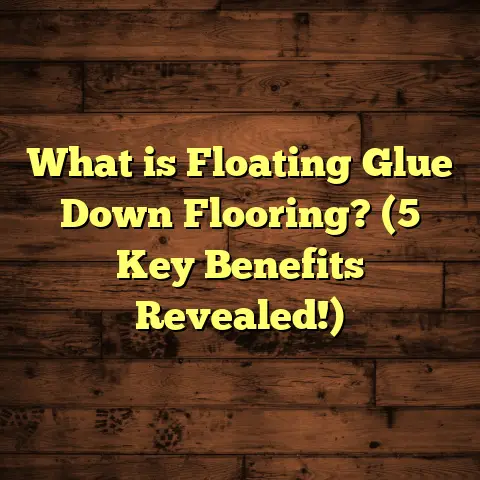What is Showroom Flooring? (5 Stunning Styles You Must Know)
Customizability is the first thing I think about when we talk about showroom flooring. The way you can tweak every detail—from the material to the finish, color, and even the installation pattern—is what makes showroom flooring so fascinating. Over the years, I’ve seen how this flexibility can completely change the feeling of a space while helping people make confident choices. Whether you’re a homeowner, contractor, or designer, understanding showroom flooring opens up an exciting world of possibilities.
What Is Showroom Flooring?
So, what exactly is showroom flooring? At its core, showroom flooring refers to the floors installed in retail or display environments where flooring materials are exhibited for customers to see and experience. But it’s not just a regular floor; these floors are meticulously planned and installed to showcase the best qualities of various flooring options.
Imagine walking into a flooring store. You see different sections where hardwood, tile, vinyl, and carpet are all laid out. These aren’t random samples; each section is a real floor designed to demonstrate color variations, finish types, installation methods, and durability under heavy foot traffic.
The goal of showroom flooring is simple: help customers visualize how the floor will look and behave in their own spaces. As someone who’s worked on many showroom projects, I can tell you that this experience is invaluable because seeing and touching materials beats scrolling through photos any day.
One thing that sets showroom flooring apart from home installations is its durability requirements. Showroom floors handle hundreds or thousands of visitors weekly, so every material chosen must resist wear and tear. The finishes are often tougher, adhesives stronger, and maintenance routines more rigorous than typical residential floors.
Plus, showroom flooring often integrates design trends and innovations before they hit the broader market. Working with these spaces lets me stay ahead of trends and see which materials gain traction with consumers.
The Purpose and Practical Uses of Showroom Flooring
Showroom flooring has two main roles that I focus on:
- Showcasing Flooring Options
This is the primary purpose. Flooring showrooms are essentially a tactile catalog where customers can touch textures, see true colors in natural or artificial light, and experience how different materials feel underfoot. This real-world interaction helps people make smarter buying decisions. - Testing Durability and Maintenance
Showroom floors are also a testing ground for brands and installers. They see how materials stand up to constant use and how finishes hold up against spills, scratches, or cleaning chemicals. This ongoing testing feeds back into product development.
Another use of showroom flooring is as an inspiration hub. Designers often use these floors to gather ideas for client projects. When I visit a showroom or design center that nails their flooring setup, I can instantly imagine combinations that would work in various homes or commercial spaces.
I once helped a showroom owner redesign their floor layout to include dynamic zones—each showcasing different flooring materials in combination with furniture and lighting. It was amazing how much more engaged customers became when they could picture the floor as part of a finished room rather than just a sample board.
Installation: What I’ve Learned Along the Way
Installing showroom flooring is quite a unique challenge compared to traditional home floors. I’ve handled projects ranging from small local showrooms to massive multi-floor retail displays. Each taught me valuable lessons about material selection, preparation, and execution.
Material Selection for Showrooms
Showroom floors face heavy foot traffic every day, so durability is non-negotiable. For example:
- Hardwood needs a tougher finish than typical residential floors.
- Vinyl tiles must be commercial-grade with enhanced wear layers.
- Carpet tiles should have stain-resistant fibers and strong backing.
I always recommend choosing materials specifically rated for commercial use when working on showrooms. This recommendation helps avoid issues like premature wear or delamination that can cause costly repairs and bad impressions.
Preparing the Subfloor
A solid base is critical for any floor but especially in showrooms. Uneven subfloors can cause tiles to crack or boards to squeak.
I’ve seen cases where rushed subfloor prep led to problems down the line—like tiles popping loose or hardwood cupping. To prevent this:
- Use leveling compounds on concrete slabs.
- Check moisture levels carefully; excessive moisture is a common cause of failure.
- Install proper underlayment suited to the material type.
In one project for a showroom in Chicago, we had to install a moisture barrier over a slab that had high humidity levels before laying engineered hardwood. Ignoring this would have resulted in warping within months.
Installation Techniques
Showroom floors often require stronger adhesives or mechanical fastening methods due to heavy use.
For example:
- Hardwood may be nailed down instead of floated.
- Luxury vinyl tiles usually require commercial-grade glue with longer open time.
- Porcelain tile installation includes high-quality grout sealers for stain protection.
Because showrooms have tight opening schedules, I’ve learned that planning each installation stage carefully is essential. Coordinating supplies, labor, and inspections prevents costly delays.
Lighting and Design Considerations
How a floor looks depends heavily on lighting. In showrooms, lighting is designed to highlight textures and colors effectively.
I once worked on a showroom where we experimented with different lighting angles and bulb types before finalizing hardwood finishes. It was surprising how much impact lighting had on perceived color warmth and gloss level.
When installing showroom floors, I always collaborate with lighting designers to ensure their setups complement the floor’s appearance perfectly.
Maintaining Showroom Floors: My Approach
Maintaining showroom flooring requires more effort than typical home floors because of constant traffic.
Based on my experience:
- Daily sweeping or vacuuming removes grit that scratches surfaces.
- Frequent damp mopping with pH-neutral cleaners keeps floors clean without damage.
- Entrance mats reduce dirt tracked inside.
- Scheduled deep cleans restore shine.
- Regular inspections catch wear spots early for repair.
For hardwood showrooms, I recommend applying fresh coats of polyurethane every 12–18 months depending on usage intensity. For vinyl or tile floors, resealing grout lines yearly helps prevent staining.
One interesting thing I’ve noticed: showrooms with proactive maintenance plans avoid costly replacements or refinishing jobs that can disrupt business operations.
Five Stunning Showroom Flooring Styles You Should Know About
Let me walk you through five popular showroom flooring styles I’ve worked with extensively. These styles blend beauty with practicality and suit different tastes and settings.
1. Wide-Plank Hardwood Flooring
Wide-plank hardwood has become a favorite among designers and homeowners alike—and for good reasons.
Why it stands out:
- Larger planks showcase grain patterns impressively.
- Creates an open, airy feeling in rooms.
- Available in many wood species from oak to walnut.
Installation notes:
Wide planks require careful acclimation—boards need at least 72 hours in the installation environment to adjust moisture content properly before nailing or gluing down.
Maintenance tips:
Avoid using water liberally; stick to dry dusting and occasional polishing with products designed for hardwood.
My personal story:
I once installed wide-plank white oak in a designer showroom that wanted to emphasize natural textures. The wood’s character matched perfectly with rustic furniture displays and natural fiber rugs. Customers kept asking where they could get such floors for their homes—a sign of success!
Data insight:
According to recent industry reports, wide-plank hardwood floors can add up to 5% value to properties due to their luxury appeal.
2. Luxury Vinyl Tile (LVT)
LVT has changed the flooring game by combining style with durability and ease of care.
Why it’s popular:
- Waterproof and resistant to stains.
- Mimics natural wood or stone convincingly.
- Softer underfoot than tile or hardwood.
- Great for high-traffic areas like showrooms.
Installation tips:
Many LVT products install as floating floors with click-lock systems or glue-down options depending on the subfloor condition.
Maintenance:
Simple sweeping plus damp mopping is usually all you need.
Experience note:
I installed LVT in an active showroom where spills were frequent due to an adjacent café area. The LVT held up perfectly without discoloration or warping after one year—impressive!
Market data:
LVT sales have grown steadily by around 15% annually over the past five years as people demand both beauty and practicality.
3. Porcelain Tile with Wood Look
Porcelain tiles that mimic wood combine elegance with toughness—perfect for commercial settings like showrooms.
Benefits:
- Water-resistant unlike real wood.
- Scratch-resistant surface.
- Can be used indoors or outdoors.
- Easy maintenance compared to hardwood.
Installation notes:
Requires professional grout sealing because grout lines can stain otherwise.
Care tips:
Non-abrasive cleaners keep tiles looking fresh without dulling the finish.
Case study from my work:
A large multi-brand flooring showroom switched from carpet to porcelain wood-look tiles in main walkways. They reported a 20% reduction in maintenance costs within six months due to easier cleaning needs and better durability.
4. Patterned Carpet Tiles
Carpet tiles offer versatility in style while providing sound absorption—a bonus in busy stores.
Why I like them:
- Mix-and-match options allow creative designs.
- Easy replacement of worn or stained sections.
- Provides comfort underfoot.
- Reduces noise levels substantially (up to 40% less noise reported).
Installation:
Peel-and-stick varieties make installation quick and allow future changes without major work.
Maintenance:
Regular vacuuming plus spot cleaning keeps them looking good long-term.
My unique insight:
For one showroom revamp project, we created geometric patterns using carpet tiles that became an instant hit with visitors—both functional and artistic!
5. Polished Concrete Floors
Polished concrete has gained traction for its minimalist look combined with incredible durability.
Why it works well:
- Low-maintenance surface requiring only occasional resealing.
- Reflects light well—brightens interiors naturally.
- Eco-friendly because it uses existing slabs instead of new materials.
- Can be customized with stains or dyes for unique looks.
Installation process:
Grinding concrete slabs with diamond pads gradually removes surface imperfections then polishes them smooth.
Care:
Mild soap washes and periodic resealing maintain shine.
Experience highlight:
In one showroom project, polishing existing concrete saved thousands compared to full floor replacement while achieving an ultra-modern aesthetic—clients loved it!
Design Trends Impacting Showroom Flooring Choices
Over my years in flooring, I’ve noticed some trends shaping what shows up in showrooms:
- Sustainability: More customers ask about eco-friendly options like bamboo or reclaimed wood.
- Mixed Materials: Combining wood with tile or carpet for texture contrast.
- Vintage & Distressed Looks: Floors that feel lived-in yet stylish attract a lot of interest.
- Bold Patterns: Chevron and herringbone patterns keep gaining popularity.
- Smart Flooring: Advances like antimicrobial coatings are being integrated for health-conscious environments.
Showrooms tend to adopt these trends early because they want clients to see what’s possible before trends saturate the market.
Common Challenges in Showroom Flooring Projects
Every project brings challenges I’ve learned how to handle over time:
- Heavy foot traffic wear: Choosing materials with industrial-grade finishes solves this.
- Moisture issues: Testing subfloors early prevents damage later.
- Tight deadlines: Careful scheduling avoids rushed installations that compromise quality.
- Lighting inconsistencies: Collaboration with lighting pros ensures floors look great under different conditions.
Sharing some stories might help:
Once during a large showroom buildout, unexpected moisture was found in the slab after demolition began—a potential disaster! We paused work, installed vapor barriers, then proceeded carefully which saved the floor from future problems.
How FloorTally Helps Me Manage Costs Efficiently
Budgeting is always on my mind when handling flooring projects—especially complex ones like showrooms where multiple materials coexist.
FloorTally is my go-to tool because it consolidates all calculations into one place based on real local costs for labor and materials. This means no surprises after ordering supplies or starting work.
Here’s how I typically use it:
- Input project dimensions including waste factors (usually around 5–10%).
- Select material types from their extensive database.
- Get detailed cost breakdowns showing labor vs material expenses.
- Adjust variables like installation complexity or product quality as needed.
- Generate reports for clients or internal budgeting easily.
For example, during a recent mixed-material showroom project involving wide-plank hardwood and luxury vinyl tile sections, FloorTally gave me clear insight into where money was going so we could optimize choices without sacrificing quality or appearance.
Wrapping Up What Showroom Flooring Means for You
Understanding showroom flooring isn’t just for pros like me—it’s valuable if you’re planning your own floors too. The ability to see and feel materials close up removes guesswork and boosts confidence in your choices.
The styles I shared reflect just how diverse showroom flooring can be—from warm wide-plank hardwoods to sleek polished concrete—each offering unique benefits depending on your space’s function and style preferences.
Installation quality matters hugely here; durable adhesives, proper subfloor prep, and smart design details ensure floors last long while looking great despite heavy use.
Maintenance routines tailored to each material keep them fresh without excessive effort—something I emphasize with every client whether residential or commercial.
And if you’re ever crunching numbers for your own project budget, tools like FloorTally make cost estimation straightforward so you can plan realistically from start to finish.
Feel free to reach out if you want advice on specific flooring types or help figuring out your next project! After all these years on site and behind desks planning installations, sharing what I know always makes my day better.





